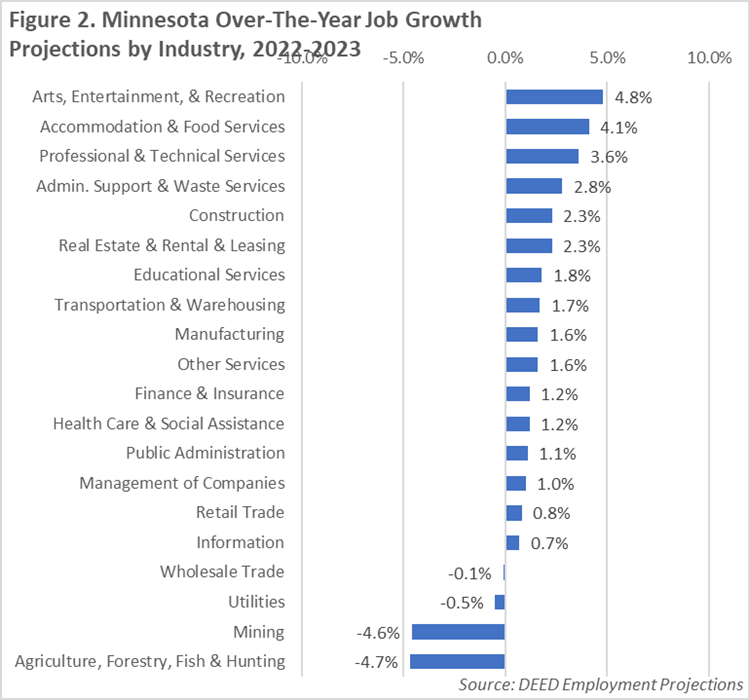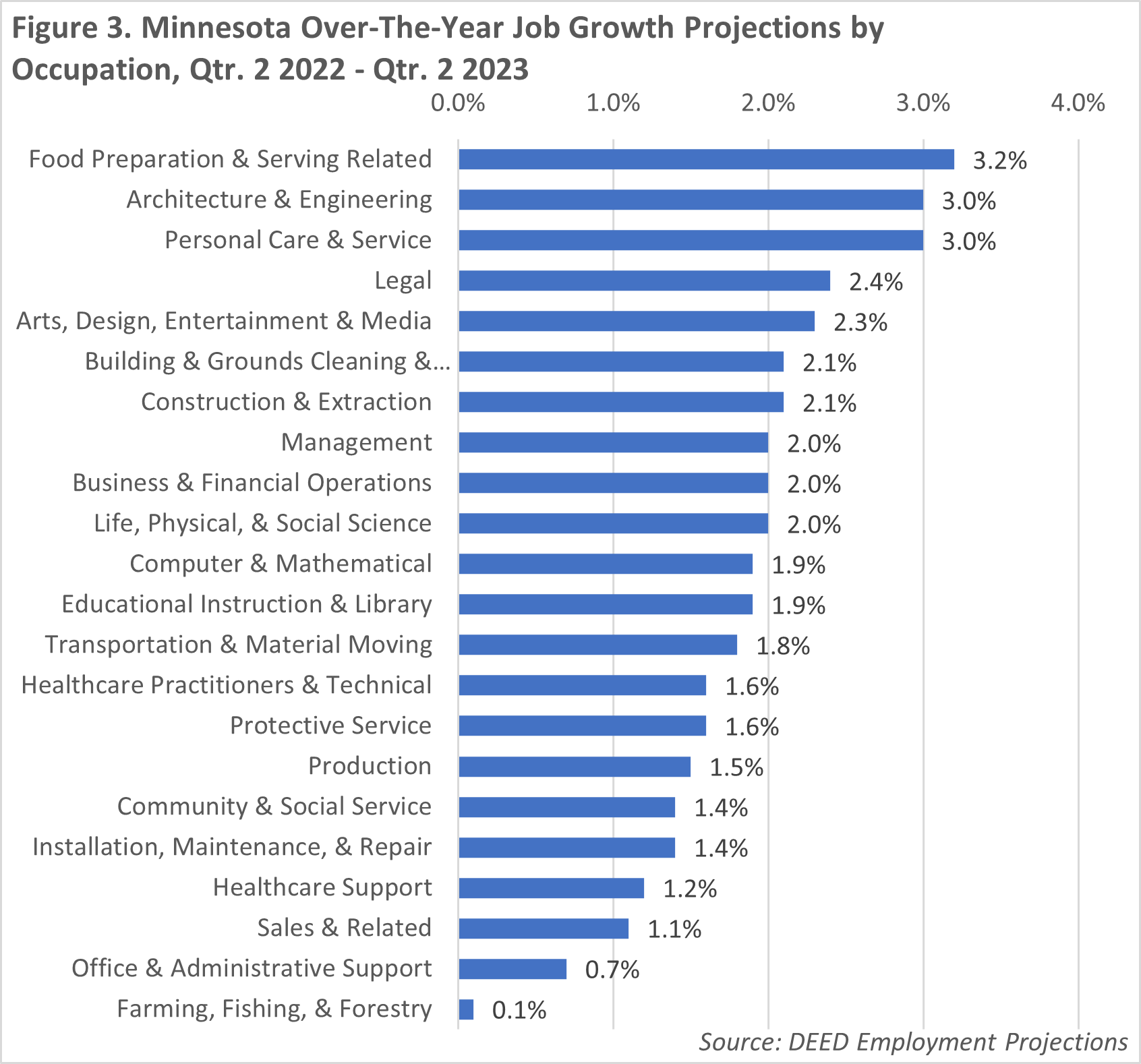
by Cameron Macht
September 2022
Minnesota's economy is projected to continue to grow over the next year, with our short-term jobs forecast surpassing pre-pandemic February 2020 employment levels by the second quarter of 2023. According to newly released 1-year employment projections, Minnesota is expected to have about 2,980,000 jobs by second quarter 2023 – a recovery of just over 345,000 jobs since the start of the pandemic.
For context, just before the pandemic broke out at the end of first quarter 2020, Minnesota had an average of about 2,940,000 jobs, including nearly 2,950,000 jobs in February 2020. Then employers quickly cut nearly 308,000 jobs through second quarter 2020 during the 2-month pandemic recession. Since then, Minnesota has worked its way back to economic health despite labor force constraints, supply chain issues, rising inflation, an on-going global pandemic, and other challenges.
By second quarter 2022, Minnesota was back to 2,927,484 jobs, which was 12,386 jobs behind the pre-pandemic employment level in first quarter 2020. Looking forward, Minnesota is forecasted to add another 50,592 jobs to its economy from second quarter 2022 to second quarter 2023, a 1.7% growth rate (see Figure 1).

Though that is slower than the 8.4% recovery-related jump from second quarter 2020 to second quarter 2021, and a more steady 2.6% increase experienced from second quarter 2021 to second quarter 2022, it is still more than twice as fast as job growth reported prior to the pandemic, when Minnesota grew 0.8% from second quarter 2018 to second quarter 2019. Once the state is back to pre-pandemic employment levels next year, we would expect growth rates to match this more moderate pace again, or perhaps even slow due to labor force constraints.
Data show that Minnesota's economy likely could have recovered more quickly, but long-term demographic trends and the short-term shock of the pandemic recession changed our labor force availability. There is no shortage of jobs – our most recent Job Vacancy Survey showed a record level of job postings in the state – but there is a shortage of available workers to fill those jobs. At 1.8%, Minnesota set a new record for lowest unemployment rate in June and July. It was not just the lowest rate in state history, it was also the lowest rate any state in the U.S. has ever reported!
By several measures, Minnesota is proving to have one of the tightest labor markets in the U.S., including nearly four job vacancies for every unemployed jobseeker. In second quarter 2022, Minnesota had an average of just over 62,000 unemployed workers, compared to an average of almost 230,000 job vacancies in the monthly Job Openings and Labor Turnover Survey (JOLTS) from the Bureau of Labor Statistics. With record low unemployment rates, employers have fewer jobseekers to pick from and are not able to hire as quickly as desired and some are not able to fill all their available jobs.
The good news is that through June 2022, Minnesota had added almost 47,000 additional workers to the labor force since January, all of whom found jobs. The number of unemployed workers also dropped by more than 30,000 from January to June as those workers also got jobs, resulting in Minnesota's continued economic growth and plummeting unemployment rate. And while the labor force was up by nearly 75,000 workers over the year, it is still down about 35,000 workers compared to 2019, prior to the pandemic.
Without much room to lower the unemployment rate further, Minnesota will need more and new workers to enter the labor force over the next year to sustain this economic recovery and create additional job growth.
Short-term employment projections provide an estimate of future job demand by industry and occupation based on statewide Current Employment Statistics, industrial and occupational trends identified by the Bureau of Labor Statistics and the Projections Managing Partnership, Minnesota-specific staffing patterns, and analyst input. Each one-year forecast is a snapshot in time that provides our best estimate of employment changes based on existing conditions. These projections are useful for employers, career counselors, educators and others to help them make informed decisions, but are not guaranteed because there are so many factors, some unknown and unpredictable, that can influence them.
Our one-year job projection shows continued growth in most major industries in the state, with only four industries projected to see declines. The two industries hit hardest during the pandemic – Arts, Entertainment & Recreation and Accommodation & Food Services – are projected to see the strongest job growth over the coming year, with both expanding more than 4%. In contrast, two industries that fared better during the pandemic recession – Mining and Agriculture, Forestry, Fishing & Hunting – are both expected to see more than 4% declines moving into 2023.
Though the percent changes are similar, it's important to point out the difference in the actual job change. The 4% growth in the Leisure & Hospitality industries would equate to more than 10,500 additional jobs, whereas the 4% drop in the Natural Resources categories would reflect just over 300 jobs lost.
Accommodation & Food Services is projected to see the largest job growth, adding just over 8,500 jobs over the year, for a total of 217,600 jobs. While that is up more than 87,000 jobs compared to the low point in second quarter 2020, it is still about 14,000 jobs behind the pre-pandemic level in the second quarter of 2019.
Health Care & Social Assistance and Professional & Technical Services are both expected to add just under 6,000 additional jobs over the next year. While that would push Health Care & Social Assistance just above its pre-pandemic employment average after a year of measured growth, it would be a continuation of the strong expansion experienced in Professional & Technical Services since the pandemic recession.
Manufacturing is also projected to add just over 5,000 jobs in the next year, a steady 1.6% increase. This follows two years of rapid growth, including a gain of 17,000 jobs from second quarter 2021 to second quarter 2022 as employers surpassed pre-pandemic employment levels. If growth occurs as forecasted, Manufacturing employment would be at its highest level in the state since 2008, right before the Great Recession.
Job growth is also expected to be strong in Administrative Support & Waste Management Services, which includes temporary staffing and other services for businesses; Construction, which is already back above levels last seen prior to the Great Recession; and Real Estate, Rental & Leasing, which is now back to pre-pandemic levels.
Educational Services should grow 1.8% now that schools are back to more typical hiring patterns, a gain of about 4,800 jobs over the year. The state is projected to also see steady growth in Transportation & Warehousing, Other Services, Finance & Insurance, Management of Companies, and Retail Trade. There are small declines expected in Wholesale Trade and Utilities (see Figure 2).

Trends are similar at the occupational level, with the fastest and largest growth projected for Food Preparation & Serving Related jobs driven by returning demand in the Leisure & Hospitality sector. This includes rapid growth for Fast Food & Counter Workers, Restaurant Cooks, Waiters & Waitresses, and First-line Supervisors of Food Prep Workers, with as many as 7,000 new jobs expected to be gained through second quarter 2023 (see Figure 3).

Due to the growth in Manufacturing, Professional & Technical Services, and Construction described above, Architecture & Engineering occupations are expected to grow 3% over the year, led by jumps in demand for Industrial Engineers, Mechanical Engineers, Civil Engineers, Electrical Engineers, and Architects. Likewise, Personal Care & Service occupations such as Exercise Trainers & Fitness Instructors, Amusement & Recreation Attendants, Hairdressers & Cosmetologists, Childcare Workers, and Animal Care & Service Workers are also projected to be in high demand.
Three occupational groups – Business & Financial Operations, Transportation & Material Moving, and Management – are all expected to gain about 4,000 jobs each through second quarter 2023, while Healthcare Practitioners and Healthcare Support occupations combined should add about 5,000 additional jobs despite difficulties with recruitment and retention in roles like Home Health Aides and Personal Care Aides, Registered Nurses, Medical Assistants, and Physician Assistants and Nurse Practitioners.
Again, reflecting the recent and projected growth in Manufacturing, Production occupations are expected to ratchet up by 1.5%, or 3,200 additional jobs through 2023. Despite expecting slower growth over the year, there is still going to be a notable number of jobs added in Sales & Related and Office & Administrative Support occupations, which should both gain around 2,500 jobs over the year, in addition to a huge number of labor market exit openings – jobs that become available as existing workers retire or leave the labor force for some other reason.
Minnesota has continued to add jobs since the outset of the pandemic recession and should surpass its February 2020 employment level by the second quarter of 2023. However, labor force availability remains a constraint on growth, with Minnesota exhibiting the tightest labor market in the county. Job vacancies outnumbered unemployed workers by a 4-to-1 ratio in second quarter 2022, which was double the nationwide ratio.
Remarkably, from a data standpoint, all 45,000 available workers that have come into the labor force so far this year have found jobs, and about 30,000 workers went from unemployed to employed as businesses filled openings across the state. The state still had more than 225,000 job vacancies, though, and was still missing about 35,000 workers from the labor force, leaving many more openings yet to be filled.